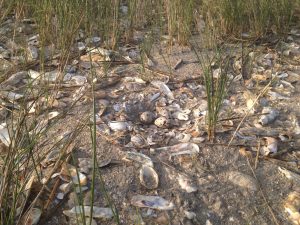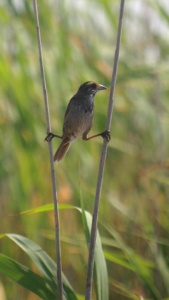By Ashley Peele

Maeve Charlesworth and Joey Coker
Birds are a class of animals that inspire people. Those who study birds, write about them, photograph and watch them, find their intelligence, beauty, and adaptability inspiring. For those involved with the VA Breeding Bird Atlas project, the biological imperative that drives birds to raise, protect, and fledge their young can be astonishing. The Phoebe with a nest perched precariously in a Chik-Fil-A sign or the Kingbird doggedly driving a black snake away from its nest. All such observations teach us something about the endurance and persistence of birds to survive and reproduce, sometimes in very difficult surroundings.
For those whose job is to work with the biologists, birders, and volunteers that study and collect data on birds, there is another important source of inspiration. Oftentimes, remarkable people are the ones who show us what courage, persistence, and commitment to a cause looks like. In this installment of our Atlas series on exceptional volunteers, we’d like to introduce you to Maeve Charlesworth and Joey Coker, a young couple living in Essex county whose own story is a source of inspiration.

Maeve taking bill measurements of a fledgling Oystercatcher
None of us can resist a romance that is at least partially founded in a shared love of birds. Four years ago, Maeve and Joey met while working for the National Wildlife Refuge (NWR) system, she at Chincoteague and he at the Rappahannock River Valley. They fell in love, sharing a mutual passion for birds, wildlife, and environmental conservation.
Maeve grew up in south-central Pennsylvania, where she and her mother became involved with Project Owlnet. Beginning in the 9th grade, Maeve helped band migrating Saw-whet Owls every Fall. It is hard to imagine completing homework in between mist-net checks, but this was her life for four years. Maeve went on to earn a B.S. in Fisheries and Wildlife Biology from California Univ. of Pennsylvania and intended to pursue a career working with birds of prey. However, landing a job at Chincoteague pulled her into the world of shorebirds and she hasn’t looked back. For three seasons, Maeve worked for The Nature Conservancy on breeding American Oystercatchers, Piping Plovers, and many other colonial bird species that nest on the Eastern Shore of Virginia. ‘No words could ever describe the amazing opportunity that it was to be out there every day, witnessing all the breeding activity from shorebirds to waterbirds to passerines. Being able to work out there instilled in me a post-college passion for conservation.”

Joey birding the dunes (Maeve Charlesworth)
Joey is a native Virginian, hailing from Middlesex county where he too grew up with a passion for wildlife. Living on the Rappahannock River as a child, he was surrounded by beautiful habitats, abundant wildlife and began birding at a young age. Regular family trips to Chincoteague further instilled a passion for birds. While earning his B.S. in Biology at Christopher Newport University, Joey spent two seasons working at Rappahannock River Valley NWR as a Pathways student. After graduating, he moved to Delaware to work as a USFWS biologist, stationed at Bombay Book NWR, which is a beautiful refuge full of incredible salt marshes loaded with interesting breeding birds, reptiles, and amphibians.
Two and half years ago, Joey was injured in an automobile accident that left him wheelchair-bound. However, as Maeve put it, such an event could not diminish his love of birding. After navigating all the adjustments that their new life would require, Maeve and Joey settled in Essex county and since the start of the Atlas project, they have contributed valuable breeding data in an area of VA with low densities of people, let alone birders.

Shorebird nest (Maeve Charlesworth)
When asked what drew them to the Atlas project, Maeve shared the following…
“Conservation and birding mean even more to us now that we don’t have the exact same career opportunities, as we did before. Even though I have been eBirding since 2011, contributing data to citizen science projects like the Breeding Bird Atlas gives us a new purpose after tragedy. Since most of my breeding bird knowledge and experience revolves around shorebirds, I love that the Atlas has expanded our knowledge to include all types of birds just by slowing down and taking the time to pay a little extra attention to what the birds are actually doing. And although birding now is not what it used to be for us due to accessibility limitations, we capitalize on places that are accessible. We drive around and bird on backroads where little to no data has been gathered.”
Visiting under-birded areas is extremely valuable for the project, given that so much of the current data is clustered around large urban areas like Virginia Beach or Richmond. Spending time surveying Atlas priority blocks in under-birded regions can make a big impact, something the region-five coordinator, Ellison Orcutt, can attest to, “Maeve and Joey have been excellent contributors to the Atlas in region 5 and on the middle peninsula. Great field skills along with a willingness to learn and improve their Atlasing techniques have made them invaluable and I’m grateful to get to work with them.”
A willingness to learn and adapt to a somewhat different style of birding is an important

Seaside Sparrow (Maeve Charlesworth)
characteristic of volunteering for the Atlas project. Since BBAs only roll around once every 20 years or so, most participants (coordinators included!) experience a steep learning curve. For Maeve and Joey, the most interesting learning experience thus far has been noting the differences in bird activity and behavior as the season progresses. Browne State Forest lies within one of their priority blocks. “One week, the most popular birds I hear are Ovenbirds. The following week they are almost silent, which allows me to hear the Wood Thrushes calling much deeper within the forest. Prior to this I hadn’t birded a location (other than my home) that often, so it really drove home how important repeat visits are to get a true picture of what species are using a given habitat.” Maeve and Joey’s experience in Browne State Forest highlights an important Atlas survey recommendation, which is spreading birding visits throughout the breeding season. As she pointed out, this ensures a fuller picture of the bird community using a given habitat or area.
Along with Ellison, we are privileged to know and work with dedicated volunteers like Maeve and Joey. Overcoming circumstance is no easy thing and is made all the more admirable when motivated by a desire to continue contributing to the causes that one is passionate about. We are grateful that Maeve and Joey’s passion for birds and wildlife conservation has led them to seek out citizen science projects, like the VABBA2. Data collection in the middle peninsula has and will continue to benefit from their efforts and we will all benefit from their example of perseverance and dedication.
~ Dr. Ashley Peele, VABBA2 State Coordinator

